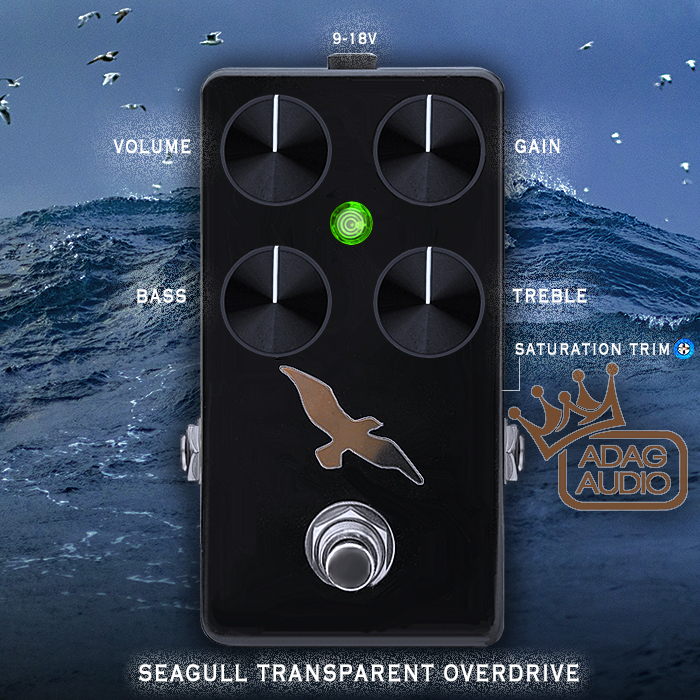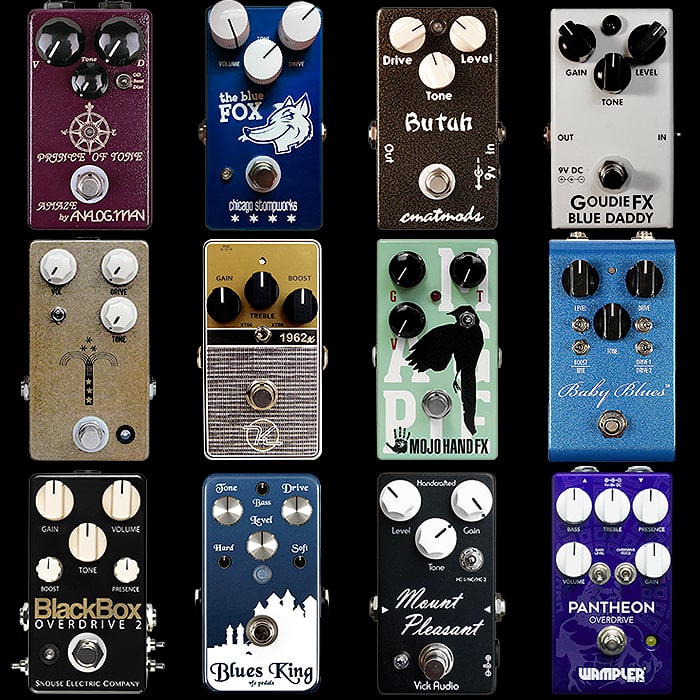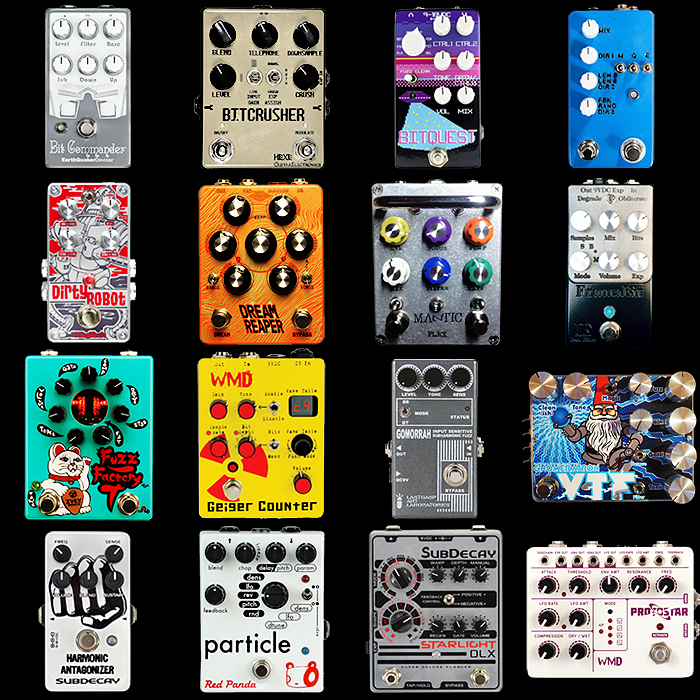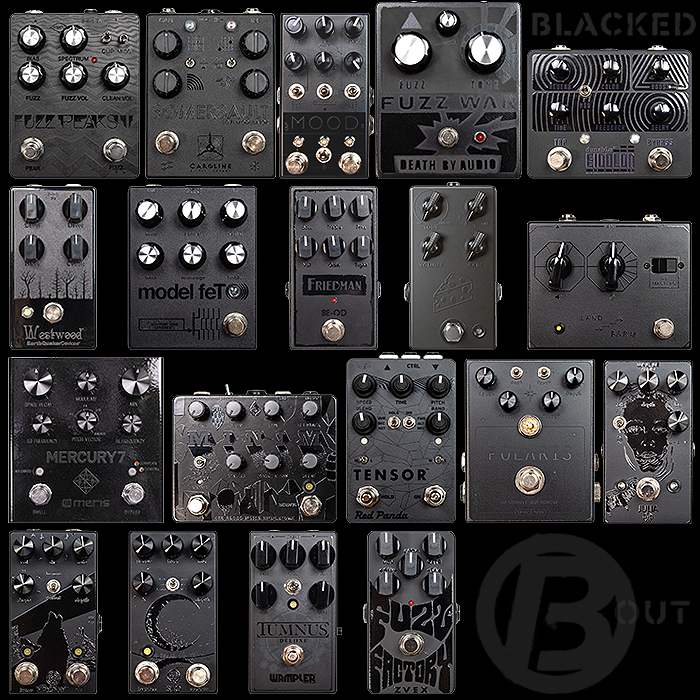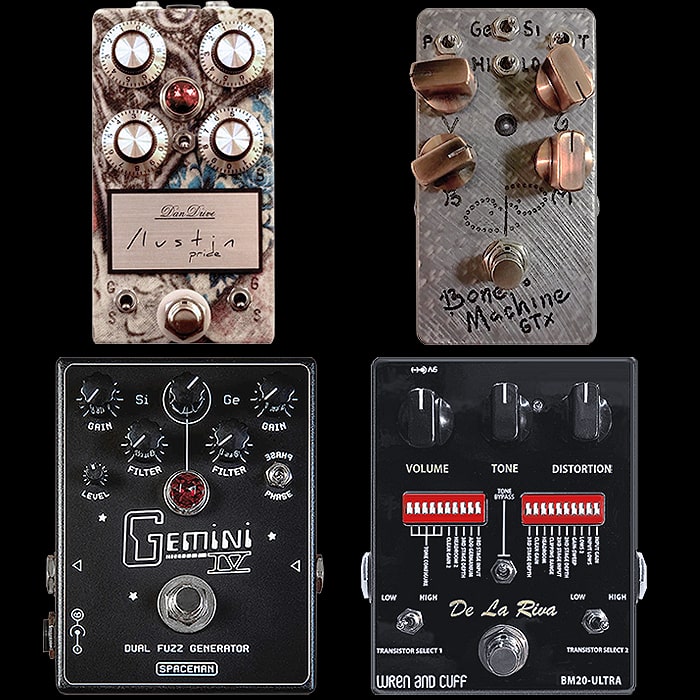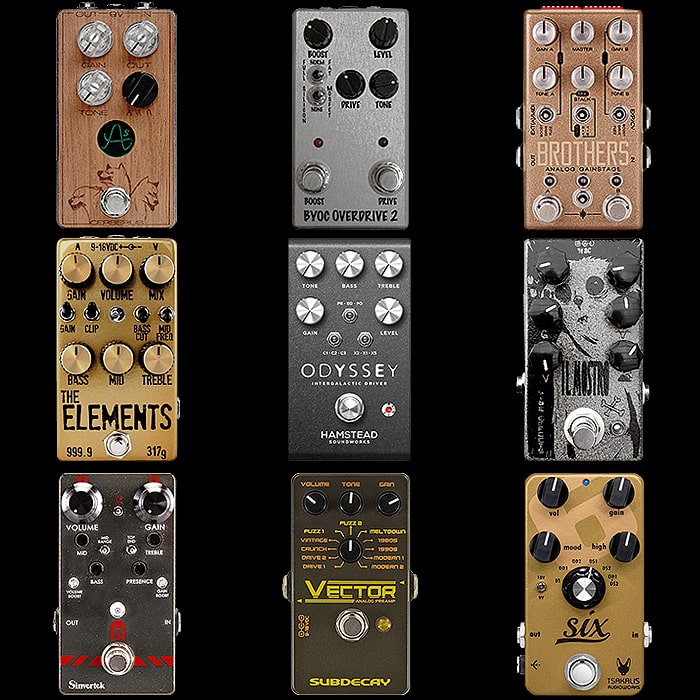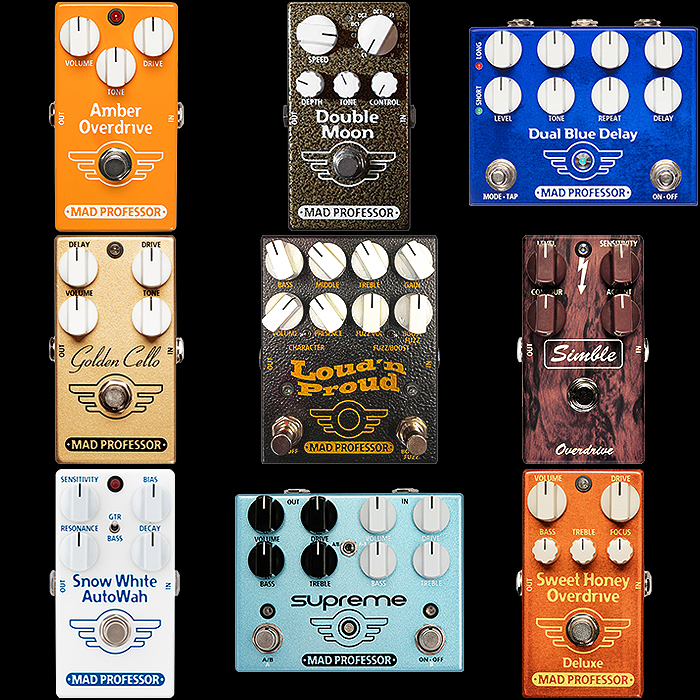Pedal Design 101 - All about Pedal Knobs, and why more brands should have their own signature versions

They are a key functional element to all pedals - in terms of working practicalities, look and tactile feel - and there are hundreds, if not thousands of possible varieties and variants, yet certain types of Knobs tend to dominate. Ever since we’ve had electrical devices - well over 100 years now, we have had a variety of control knobs and dials - initially metal, then bakelite, and now mostly modern plastics, hardened rubber and aluminium.
In doing this feature/guide I referenced 5 sites in particular - Davies Molding, Mammoth Electronics, Small Bear Electronics, Amplified Parts and Don’Audio. I was slightly surprised that there seems to be a general lack of proper part-number referencing all-round - with certain designation knob types nigh on impossible to find. Unlike the Effects Database (Pedals), there exists no equivalent for Amp/Guitar Pedal Knobs - which I feel though could be / would be an essential resource for pedal-builders.
In knob manufacturing Davies Molding (Harry Davies) is sort of the equivalent to Hammond Manufacturing (key enclosure sizes) - and is the only regularly referenced product code - e.g. Davies 1510 style or 1400 series, 1900 series etc. Beyond that though knobs are really just referenced per their most common use - so Boss-style, MXR-style etc. Note that I reference Davies Molding series numbers with the prefix DM-.
In making a particular type and size of pedal obviously the enclosure size is of critical importance, along with the number of parameter functions required to control the pedal. If you have a large number of parameter controls - it obviously follows that the knobs/dials employed need to be on the more compact side to fit within the available surface area.
In designing a pedal layout - the circuit is of course the first consideration, but then the control layout/topology - how many knobs you are going to need, and where they will best sit on the interface as such. There are all manner of odd pedals out there with knobs and switches literally and liberally sprouting from every surface, but in the main - it makes most sense to mount the knobs on the top surface, as one of the major benefits of using this style of pedal is the visible cues you get from being able to see exactly what level/s the knobs are set at.
I fairly arbitrarily settled on a grid size of 25 per the above visual, but then systematically and methodically scanned through my various features and own pedal collection to end up with the particular varieties featured. There are of course several types omitted, but I hope to have captured the vast majority of the most significant ones. In my usual fashion I’ve mixed up established classics with personal favourites, new-comers and novelties. Part of the purpose of this feature is to generally encourage pedal-builders to be a touch more creative, selective and personalised when it comes to deciding on which knob types to deploy.
Several of my favourite brands have their own signature knobs, and I would encourage the majority of established brands to look into designing and commissioning their own varieties, while this does not make sense for smaller and more fledgling builders. The knobs are sort of arranged both by approximate ubiquity and symmetry - I moved around a few at the end to make for a more aesthetically pleasing presentation - this article took quite a bit longer to complete than initially estimated - I hope you enjoy this overview!
MXR Style Knobs - ECB-071/130, DM-1250 etc.
I would say that the 3 most ubiquitous styles of knob nowadays are the MXR. Boss and DM-1510 styles - with likely the last mentioned the current most used, followed by roughly equal numbers of Boss and MXR style ones. The official MXR knobs are the heptagonal ones with a skirt, and JHS famously uses these knobs too, while several others use the DM style variations without the skirt. These of course come in a variety of sizes - with and without skirt (not MXR) and in a multitude of colours.
Leading adopters:
- MXR
- JHS
- Analog.Man
- Basic Audio
- Buffalo FX
- Cooper FX
- Crazy Tube Circuits
- Demon Pedals
- DOD
- Emma Electronic
- Keeley Electronics
- Maxon
- Menatone
- Mojo Hand FX
- Red Witch Pedals
- Stomp Under Foot
- Strymon
- Tech 21 NYC
- Toneczar
- Truetone
- Vick Audio
- Wilson Effects
Boss Style Knobs - DM-1100/1360, Boss-Mid et al.
In a not altogether dissimilar vein to MXR, Boss also largely uses skirted heptagon control dials but with silver tops. In fact the Boss-style dial is probably the second most used design overall after the 1510 type (could be MXR type though also). Yet Boss also has a number of additional smaller knob styles that are used on many of its pedals - dual-concentric and more standard deviation. I struggled to find any specific reference to those, possibly from a very particular Japanese manufacturer! Much like the MXRs, these come in a variety of sizes and colourways. Upon completing the review it would seem that there are actually more builders using the MXR-styles, while the Boss-style is used for a very large number of secondary applications too.
Leading adopters:
- BOSS
- Dawner Prince
- Death By Audio
- Drolo
- Jackson Audio
- Matthews Effects
- PLBR Effects
- Strymon
- Tomkat Pedals
DM-1510 Style Knobs
This has to be the most ubiquitous of the pedal knob designs - as it's seen pretty much everywhere. It's obviously a very simple and elegant design and creates a dial which is easily adjustable. I associate it most with Wampler - I guess as that's one of my favourite brands, but you see it in very widespread use on just about every pedalboard.
Leading adopters:
- WAMPLER
- MAD PROFESSOR
- Anasounds
- Animals Pedal
- Carl Martin
- CMATMods
- Custom Tones
- Darkglass Electronics
- Free The Tone
- Friedman
- Fulltone
- Fuzzrocious
- JAM Pedals
- Greenhouse Effects
- Lone Wolf Audio
- MI Effects
- Mooer
- Paul Trombetta Design (Gold/Copper)
- Providence
- Retroman Music
- SolidGoldFX
- Source Audio
- Seymour Duncan
- Suhr
- Tate FX
- Tsakalis AudioWorks
- Zander Circuitry
DM-1400 Style Knobs
It's likely the Klon is the most immediately associated pedal with these beak-like pointer knobs, and in fact this style of knob tends to be a secondary flavour for most of the brands that use it rather than their predominant variety. In fact a number use it solely for their own version Klon clone! Fairfield Circuitry though uses this knob for its whole range, and J Rockett for its Tour Series.
Leading adopters:
- KLON
- FAIRFIELD CIRCUITRY
- J Rockett
DM-2300, Chicken-Head/Mini-Chicken-Head, Evolved/Pseudo-Chicken-Head
The Chicken-Head style of knob which is still popular on vintage-type amps is largely used as a secondary flavour by most pedal-builders - with the exception of those listed below. I most associate this style of knob with Cusack Music and Thorpy FX while you can see examples of more specific applications within numerous other pedal ranges. Bogner uses two different types for its non-Rupert-Neve type pedals.
Leading adopters:
- CUSACK MUSIC
- THORPY FX
- Bogner
- Lunastone (Larger Pedals)
- T-Rex Made In Denmark Pedals
- Union Tube & Transformer
Vintage Fender-Amp-style, 'Cup Cake'
This is another typically secondary flavour, although made famous more recently by Vemuram - as utilised on its Jan Ray pedal and a few others (TSV808). Tone City also use these sorts of knobs on their larger pedals, but generally these are not seen around as much of late.
Leading adopters:
- Tone City (Large Pedals)
- Vemuram
Vintage Marshall-Amp-Style, Knurled Gold/Silver-top
The Marshall Amp knobs are pretty much ubiquitous nowadays, although they don't form the principal element of any pedal range currently. In the main they are simply used to accentuate Marshall-style pedals within a variety of different ranges. I have three pedals in my collection with this style of knob - two silver, and one gold - the Alexander Pedals Jubilee Silver Overdrive, Hudson Electronics The Fuzz and Dr Scientist's The Elements. These knobs are also used in part on the Pettyjohn Electronics range and Ramble FX Marvel 3 Drive amongst a smattering of others.
Leading Adopters:
- Pettyjohn Electronics
DM-1140/1150/1155 Style Knobs
A while back I foolishly thought this was BYOC's own commissioned knob type, but it's a Davies Molding standard - available in different sizes and colours as usual. I'm still most familiar with this from my BYOC pedals, but there are a few other makers that make use of this knob type - Skreddy's Marc Ahlfs for instance uses the larger 1155 type for his two phaser pedals, and Lovepedal's Sean Hughes uses them on the Hermida Audio pedal range. David Rolo also uses these on a few of his Drolo pedals, as does EWS.
Leading adopters:
- BYOC
- Lovepedal Hermida Audio series
DM-1900 Style Knobs, Knurled Compact Octagon
This is the 4th of the 4 leading ubiquitous knobs along with MXR, Boss and DM-1510 styles. This type is slightly narrower in gauge / more compact meaning it is used largely when you need to fit a number of dials into a fairly tight space. You see this style within a huge variety of pedal ranges, while it's the main type for Malekko, and Zvex's recent Vertical line.
Leading adopters:
- ZVEX Vertical
- Blackout Effectors
- Dr Scientist
- Dwarfcraft
- Earthquaker Devices
- Malekko Heavy Industries
- Spaceman Effects (Regular + Signature versions with 'S')
Vintage Winged Marconi Style Knobs
These vintage style knobs seem to be having something of a resurgence at the moment. I mostly associate them with the Hudson Electronics Broadcast, but they have cropped up recently too on the really cool but sadly mono only RedShift Effects Mirage Multi-Delay, and Vemuram Myriad Fuzz pedals.
Leading adopters:
- Hudson Electronics
Ribbed Silver Style Knobs
I am most familiar with these courtesy of Spaceman Effects, as this type of knob is used in a variety of colours on a number of my Spaceman pedals. It is also a secondary flavour for many builders - for special applications - e.g. Earthquaker Devices, FTelettronica and Shift Line / A+.
Leading Adopters:
- FTelettronica
- Spaceman Effects
Chrome Skirt Style Knobs with Pointer/Numbers
This is used across the whole JPTR FX range, Black Country Customs, Shin's Music, and the greater part of King Tone pedals, as well as more specialist applications for Caroline Guitar Co, Cooper FX, Demon Pedals and Earthquaker Devices. I actually associate this the most with the Rainger FX Freakenstein/Chop Fuzzes where it's just the perfect shape of dial to suit that concept.
Leading Adopters:
- JPTR FX
- King Tone
- Laney / Black Country Customs
- Rainger FX (Freakenstein)
- Shin's Music
Chase Bliss Audio Anodised Milled Aluminium Knobs
These are probably my favourite type of knobs overall on my favourite type of pedal layout - everything about Chase Bliss Audio just exudes high attention to detail and the highest level of quality. You can actually buy these for $4 a piece - meaning $24 for a full set of 6 - so you can create your own colour-scheme as such. Comes in 9 colourways. I'm not that fussed about changing any of my existing ones - but this is definitely one of the brands to emulate at the moment.
9 colourways:
- Black with White line (Condor)
- Blue with Black Line (Spectre II / TR)
- Gold with Black Line (Warped Vinyl III)
- Grey with White Line (Gravitas)
- Red with Black Line (TR RKM)
- Red with White Line (Wombtone)
- Purple with White Line (Spectre I)
- Silver with Black Line (Brothers)
- Thermae (Rose Gold) with Black Line (Thermae)
Electro-Harmonix Softly Rounded Knobs
This is currently the largest pedal builder in the world by sheer range of products, yet I've never been overly enamoured by their choice of knobs - preferring the MXR-style knobs of the JHS custom versions over the originals. There's just something about them that is a touch anodyne and anonymous. As the pointer is painted on, this is often not as clear or as sharp as you would want it. I also would prefer more texture on a knob like this - some ribs/ridges to make it easier to twist. It's not a bad knob as such - it's sort of totally inoffensive, just a little bland and unergonomic for my liking. EHX definitely have the funds to build a better knob! The Catalinbread one is not too dissimilar, the same sort of softly rounded edges but with a small dot in place of the pointer line. I feel this knob sort of falls a little short against both visibility and usability criteria.
Walrus Audio 13mm Ridged Aluminium Knobs
These lovely textured aluminium knobs are deployed across the Walrus range - mostly in black, but in silver on the Jupiter Fuzz. There are several other brands which deploy a very similar style of knob - typically with a more glossy paint-job - thee include KMA Machines, Lunastone, REVV and VFE. I feel that these knobs look and function pretty well, but might be slightly too vanilla to trigger any sort of lasting brand impact/recall. I also prefer them in a more matt or brushed application versus gloss lacquer.
Supro Concave Silver-top Knobs
The Supro style of knobs is distinctive, but not without issues - you get strange reflections pooling in the dip of the mirrored top - where the top actually takes too much focus away from the fairly indistinct pointer element on the periphery of the skirt. So while being a reasonably decent differentiator, the form does not feed adequately into the function of this knob - in fact all knobs with pointers on the skirt area are inoptimal as the pointer can easily be obscured by the body of the knob - ideally all pointers should sit on the top / most visible portion for ultimate clarity at all times.
Left Hand Wrath Coloured-top, Ribbed Style Knobs
I know this style of knob best from its many appearances on Lone Wolf Audio's series of Left Hand Wrath HM-2 clone pedals. In fact such is the association of the orange-top version of this knob that my friend Guillem over at Decibelics chose the same for his Angry Swede Mini HM-2 Clone. Of course there are plenty of other colours besides orange, and this style of knob is a popular choice on several mini pedals, and as a good alternative to the more ubiquitous DM-1900 series style. I feel that the orange version is so well associated with the Death Metal genre that you would struggle to repurpose is for other means - which obviously has its pros and cons.
Skreddy Pedals Milled, Knurled Polished Aluminium Knobs
In terms of styling components, the Skreddy enclosures themselves are a rather nondescript standard Hammond 1590B style - the smaller of the compact chassis. Most of the pedals in the range only have the Skreddy logo and some text as the main graphic / branding elements - so it's left to the beautifully shaped / sculpted knobs to carry the key brand identifiers. The Skreddy knobs are a big part of the pedal design now - and show you how much a well-designed knob is worth in branding / value terms.
Origin Effects Milled, Brushed Aluminium Knobs
I have so far seen these in 2 anodised colourways in addition to the raw silver variety - orange and black/charcoal - per the RevivalDrive. These are probably my second favourite knobs overall after the Chase Bliss Audio ones. They are a beautiful example of well-engineered design where the pointer is the slit carved into the cylinder - it is deep enough to cast a dark shadow which forms a sort of black-line pointer - very clever really. The brushed aluminium is classy and has a really pleasant tactile quality to it which I prefer over the more polished / gloss varieties of aluminium knobs - also these sort of dials don't hold onto finger-prints like polished surfaces do.
Bogner Milled Brushed Aluminium Knobs with Skirt
These knobs are used throughout the Rubert Neves transformer range of Bogner Pedals - of which I have 3 - the Burnley Distortion, Oxford Fuzz and Wessex Overdrive. These beautifully textured knobs match well with the Bubinga facias of the custom line editions of these pedals - which are the ones I have. Much like with Chase Bliss, Skreddy and Origin Effects - these exude quality and a high attention to detail.
Cusack Music Custom Aluminium Knobs for Limited Edition Germanium Screamer Fuzz
Cusack Music are generally associated with the Chicken-Head knobs used throughout their range. But for this year's Winter NAMM show they produced custom signature knobs just for a highly limited pedal run. I much prefer these knobs to the standard versions and feel that Cusack should consider adopting more widespread use of the same - there are much more brand-distinct, and can be built up to be associated with just the Cusack brand of pedals. There's something about this design which funnily bring to mind The Avengers too!
Danelectro Faux Weathered Custom Vintage Knobs
Danelectro recently dug up a couple of vintage pedals and decided to re-release them in faux relic'd livery with original bakelite style knobs in two different colourways - a brown one for The Breakdown PreAmp/Drive, and a lighter almost maple-hued one for the Eisenhower Fuzz that I have on pre-order. This is obviously very much a 1960's style of knob - and all the cooler for it. I still probably prefer milled aluminium knobs overall, but in this particular context - the knobs chosen for the task were absolutely the correct choice.
Final Thoughts
I am generally very happy with the reference section above and related composite image - this took an inordinate amount of time to research, long-list and whittle down. Finding the right image references and re-touching them to similar vantage/viewpoint was also a touch trickier than expected, but I feel that this is now the perfect resource for a debate on the subject of Knob selection.
There are lots of factors which determine which knob/s are optimal for each situation - and it's totally understandable that occasional home-assembly pedals use one of the mass-market types indicated in the first half of the visual. I feel though that there are several pedal brands that could do more in this area - and should in fact have their own unique style of knobs for their pedals - used right across the range.
At the opposite end of the scale you have pedal builders like Dr No. - for whom every pedal is a separate creation and all new materials are fair game - but this is sort of across the line into pedal-art, and not really for practical marketing or touring purposes or necessarily restrictions you would wish to apply to a whole range.
As an example of the very best in knobs I have indicated my liking for Chase Bliss Audio, Origin Effects and Skreddy Pedals knobs in particular - all funnily enough textured, milled aluminium. But those both work for me aesthetically and ergonomically - and are largely compact enough to be used in any situation. The Chase Bliss ones are my favourites for a number of reasons - including how compact they are, and how useful they could therefore be in all manner of different scenarios.
With Micro Batch Manufacturing so widely available along with accessible technologies like 3D-Printing and CAD/CAM/CNC Milling and Molding - it should be within the realms of possibility for most medium-sized outfits and above to design and make/commission their own distinctive pedal knobs.
There are many more pedal-builders that have unique knobs than referenced here - Amptweaker, Big Joe Stomp Box Co, Catalinbread, Empress Effects, Lastgasp Art Laboratories, Meris, Mu-Tron, Neunaber, Occvlt Pedals, Pigtronix, Subdecay, Way Huge etc. Pigtronix just missed the cut on this occasion, while I feel that aspects of many of the others weren't entirely to me liking although some just missed the cut - and besides I'd already decided to limit the selection to 25.
I lay down the gauntlet for companies like Wampler, JHS and Keeley to design their own unique styles of knobs - it should be well within the wheel-house of those three and many more of their ilk to get back in contention with Chase Bliss Audio which otherwise threatens to pull further and further ahead of the chasing pack.









